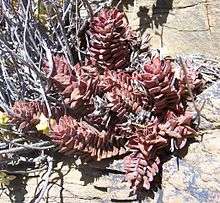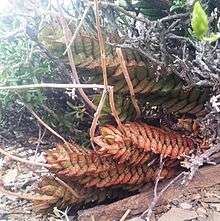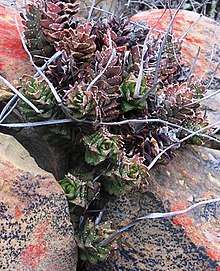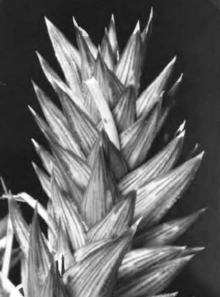Astroloba bullulata
Astroloba bullulata is a small succulent plant of the Astroloba genus, endemic to mountainous areas of the southern Cape, South Africa.
| Astroloba bullulata | |
|---|---|
 | |
| Astroloba bullulata in habitat | |
| Scientific classification | |
| Kingdom: | Plantae |
| Clade: | Tracheophytes |
| Clade: | Angiosperms |
| Clade: | Monocots |
| Order: | Asparagales |
| Family: | Asphodelaceae |
| Subfamily: | Asphodeloideae |
| Genus: | Astroloba |
| Species: | A. bullulata |
| Binomial name | |
| Astroloba bullulata Uitewaal; (L. Bolus) | |
| Synonyms | |
|
Astroloba egregia (Poelln.) Uitewaal | |
Description


Astroloba bullulata is a small, compact species of Astroloba, that reaches a height of about 30 cm. It has a dark green to deep olive-red colour.
The matt leaves are covered with distinctive black tubercles ("bullulata") that mostly occur on the outer side of the fat, shiny-margined leaves. The dense and compact leaves form a faint spiral in their growth, with each leave turned slightly inward and twisted towards the direction of the spiral. Each leaf also has a marginated keel, unlike most other Astroloba species.
The inflorescence is upright and carries sparse brownish-green flowers with yellow tepals (Flowers appear in the dry summer, November to January).[1]
Distribution
It is indigenous to the Western Cape, and a small southern section of the Northern Cape, South Africa. Its distribution lies within the districts of Ceres, Sutherland and Laingsburg. Its habitat is Karoo scrub vegetation.
Astroloba "hallii"

The unresolved population that is occasionally named Astroloba "hallii" is usually classed as an eastern variety of Astroloba bullulata. Both varieties have keeled-marginate apices to their leaves.
This plant resembles a lower, more robust variety of A.bullulata. Its lighter green leaves are thinner than those of bullulata, and have dark longitudinal lines on the leaf undersides. Some specimens also have inconspicuous pale spots, which tend to form in longitudinal rows on the leaves. The leaves densely cover the stems which reach a height of 15 cm. The flowers (November to May) are lighter than those of bullulata.
It occurs south and east of Laingsburg, on rocky ridges in shale soils.[2]
| Wikimedia Commons has media related to Astroloba bullulata. |
Further reading
References
- D.Court: Succulent Flora of Southern Africa. CRC: 2000. p.267.
- U. Eggli: Illustrated Handbook of Succulent Plants: Monocotyledons. Springer Science & Business Media, 2001. p.187.